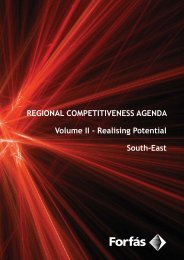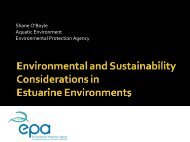Bioenergy Implementation Plan - South-East Regional Authority
Bioenergy Implementation Plan - South-East Regional Authority
Bioenergy Implementation Plan - South-East Regional Authority
You also want an ePaper? Increase the reach of your titles
YUMPU automatically turns print PDFs into web optimized ePapers that Google loves.
9.2. Selection & Description of Case Studies<br />
Previous chapters have outlined the following information:<br />
• The regional energy requirements and the current usage of bioenergy in the regional energy balance<br />
(Chapter 5)<br />
• The available bioenergy resources in the Region (Chapter 6)<br />
• An overview of which bioenergy supply chains and which bioenergy technologies are available on the<br />
market to provide bioenergy services in the heat, electricity and transport sectors (Chapters 7 and 8).<br />
Based on this information and after consideration of the regional conditions, one bioenergy supply chain for each of the<br />
three end-use sectors has been selected for further analysis.<br />
The bioenergy resource assessment in Chapter 6 showed that energy residues from forestry (from first thinnings, later<br />
thinnings and final felling) are the most substantial bioenergy resource in the Region. The use of wood fuel was thus<br />
significantly considered in the analyses.<br />
Secondly, it was considered constructive that the viability analyses should include one case study covering all three enduse<br />
sectors (the heating sector, the electricity sector and the transport sector), since the framework conditions are very<br />
different for each sector.<br />
Thirdly, taking into account that no large thermal power plants are currently situated in the Region, it was decided to<br />
focus the case study in the electricity sector on the establishment of a CHP-<strong>Plan</strong>t in the Region. Since the extension of<br />
district heating is currently rather limited in the Region a case study was developed as an industrial CHP-<strong>Plan</strong>t producing<br />
heat for internal needs and selling electricity to the grid.<br />
Figure 9.1 below shows which supply chains were analysed in each case study (marked with green, blue and red), and<br />
which supply chains were assessed qualitatively in section 9.5 (marked with grey).<br />
Figure 9.1: Overview of analysed supply chains<br />
Wood<br />
Willow OSR Manure Sugar Beet Cereal<br />
Wood Chips<br />
& Pellets<br />
Biodiesel Biogas Bioethanol<br />
Heat<br />
Combined Heat<br />
and Power<br />
Transport<br />
south-east regional authority<br />
údarás réigiúnach an Oir-DheisCIrt<br />
59





